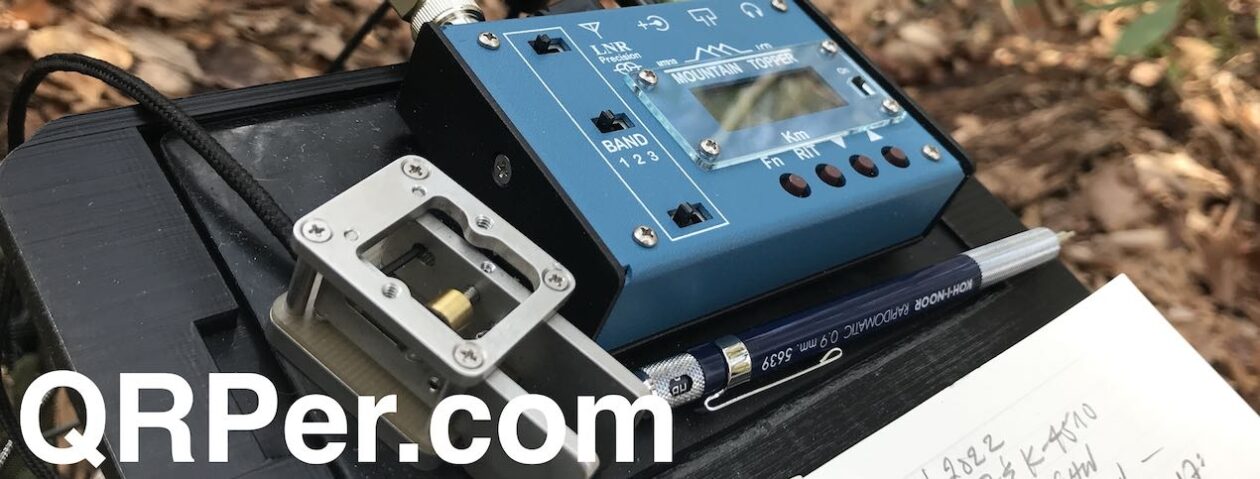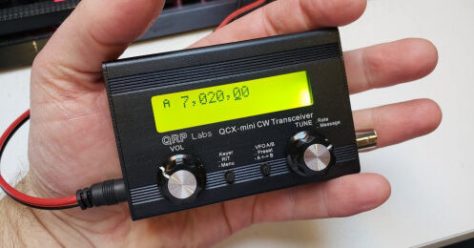 Many thanks to Frank Lagaet (ON6UU) for sharing the following guest post:
Many thanks to Frank Lagaet (ON6UU) for sharing the following guest post:
The EGV+ Three Band Transceiver Kit
by Frank Lagaet (ON6UU)
Another EA3GCY kit has seen daylight. The EGV+ is ready for you all.
It was beginning 2021 I got word a new kit from EA3GCY was ready and distribution could start. After a successful build of the DB4020 I did not need much time to decide to buy this kit, a week later the kit arrived at my QTH. As weather was good I did not start immediately building but then winter kicked in, with snowfall and frost, perfect time for some quality time and building the kit.
What do you get ?
The kit has a general coverage receiver from 6 to 16MHz, it has a keyer built in, has RIT without limit, requires only 0.25A on RX and smaller than 2A on TX. Dimensions are 18x14cm and weight is 0.3Kg. It is CW only, able to produce 8W on 40 and some 5-6 on 30 and 20. The kit has an AB class amplifier. Spurious is below -50DBc. The receiver is a heterodyne type balanced mixer, sensitivity is 0.2µV minimum and the CW filter is some 700Hz wide, the AGC is on audio. Furthermore the transceiver is equipped with both output for loudspeaker as for a headset or earbuds.
The kit arrived in a brown envelope and in that envelope I found a well-packed packet of plastic bags and the printed board well packed in bubble wrap. Around that another layer of bubblewrap. Safe!!
All plastic bags were checked, all needed stuff was there, super, well done Javier.
All components were installed in about 10 hours “relax max style”, if you have built some kits already you can easily do this one, all elements are far enough out of each other, the board is not overcrowded at all. Some attention is needed when soldering the IC’s and display but even that is a piece of cake. Be careful when installing the SI5351 module.
Winding the toroids, just follow what is in the manual, it is not that hard to do, I don’t understand what many find so difficult. Just take your time and don’t rush into it.
I got the transceiver up and running quite quick. I didn’t install a speaker in the cabinet but decided to go for a transceiver where no speaker is in. If I want to use it on SOTA or GMA I don’t need the extra weight and can take earbuds with me. So I installed the speaker connector on the board.
I made connections towards the CW key and CMD push button with jumper cables which fit exactly on the headers Javier supplies, a little glue to keep them in place is also added afterward. For easy operation I mounted the CW key connector and CMD pushbutton on the front of the transceiver.
Do to be able to withstand high power nearby stations, I mounted the EGV+ in a homemade box which is made of printboard. The box should be a Faraday cage to keep all QRM out. If you buy a box, buy one in metal. I added a laminated front and back which make the transceiver look kinda cool. Now you can also buy a box from qrphamradiokits.
Alignment
The alignment is done on 40 meters: crank up the volume and start turning the 2 coils (L1 and L2)to maximum volume. Be careful to handle these with caution and don’t use metallic screwdrivers. Connect an antenna after you’ve done that and do the alignment of the coils again for maximum volume. Find a station on 40 and redo the alignment once more. You should already have good results now.
P1 Set sidetone level to your liking.
P2 Set the hangtime of the relay after you’ve been on air–fast fingers will need a quick release. Set this to your liking.
P3 Connect a power meter between a dummy load and the transceiver, set power on 40 to some 8 Watts. Measure on 30 and 20 meters, you should find some 6-7W there. Don’t set the power to full if you want a long life for the final in the transceiver. Mine is set for 6W on 20, resulting in some 7.5W on 30 and some 8.4W on 40. I think I will reduce even more.
P4 Set to max, it is the RX-attenuator.
P5 Don’t pay too much attention to the signal meter, mine is set at 6/8 of the potmeter’s range. It is only an indication. If you don’t want the S-meter then you can do a start-up sequence with the tuning knob.
These are in fact the alignments you need to do inside the transceiver. You should also check Xtal calibration and BFO, these are settings which you need to do in the set-up. Don’t forget to write all down when you have maximised these settings. If you do a reset, all these values are erased too so be carefull.
The complete CW 3 bander
Well, you get a 3 band transceiver which you build yourself, it has RIT and XIT, has 4 memories on the KB-2 keyer, speed of CW can be set between 0 and 50WPM and you can set the KB-2 as a beacon which can be handy too. The EGV+ provides you with 3 bands which are almost for certain insurance for QSOs when going on SOTA, GMA or POTA.
You may have noticed some resemblance with the DB4020. You are right as some parts are the same on the board. The designer worked on the same platform to make two completely different transceivers. The result is twice the fun for kit builders.
I made a box myself since, at the time of ordering, there were no boxes available, here’s the result.
The naked printboard transceiver.
After adding a laminated front to the trx, it looks now like this. You can see it is not made professionally but I like it.
The paper which is between the plastic was first cut out for the display before placing it in the plastics so giving an extra protection to the display.
I have also made a retractable stand for it, when folded back it is next to the bottom of the transceiver, when folded out the stand is under the front of the transceiver, the retractable stand is also made out of printboard.
It’s an easy-to-make stand–take some old printboard and solder it together. The pictures explain it all, I think.
Meanwhile, I already made a lot of QSOs with this small (16 X 20 X 6 cm) QRP transceiver. The power out is better than expected and even reduced so all bands are within QRP regulations.
Finally, I’d like to say that I’m not sponsored to make this kit, I don’t have any ties with the kit producer, nor do I gain money with building it. If people would like to have this QRP kit built for them I’m willing to help out in populating the board and aligning it. A ready made box is available with qrphamradiokits. This also stands for the DB4020 which I made earlier.
The kit comes for 125€ without shipping costs. Many European countries will have no shipping costs at all. The enclosure comes for 50€ all included. This means you have a complete 3 band radio for about 200€. In my eyes, this is a pretty good deal.
Info about the kit can be found here : Home – Página web de ea3gcy (qrphamradiokits.com)
And here : EGV+ Three band CW – Página web de ea3gcy (qrphamradiokits.com)





































